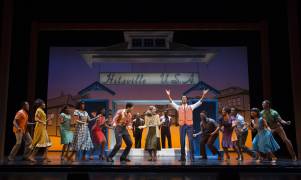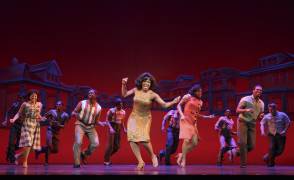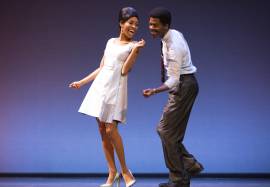
Motown Records founder Berry Gordy tells his life story surrounded by the Detroiters he turned into superstars in Broadway’s crowd-pleasing Motown: The Musical, now in its second year of touring the country and stopping for the next two weeks at the Segerstrom Center For The Performing Arts.
Told as a flashback journey down memory lane, Motown: The Musical opens with Gordy’s refusal to attend the March 25, 1983 taping of Motown 25: Yesterday, Today, Forever, the Motown exec still feeling wronged by how many Hitsville U.S.A. recording stars had over the years jumped ship for more lucrative deals with competing labels.
 From the 1938 Joe Louis-vs.-Max Schmeling prize-fight that inspired eight-year-old Berry to seek his own greatness, to the early Motown years, to Motown’s first decade of hits, to the label’s 1970s ventures into film-making, to the series of “betrayals” that marked the end of Motown’s first quarter-century, Motown: The Musical tells it all (or at least what book writer Gordy wants us to know), punctuated by five dozen or so Motown hits and a couple of new songs written expressly for the show.
From the 1938 Joe Louis-vs.-Max Schmeling prize-fight that inspired eight-year-old Berry to seek his own greatness, to the early Motown years, to Motown’s first decade of hits, to the label’s 1970s ventures into film-making, to the series of “betrayals” that marked the end of Motown’s first quarter-century, Motown: The Musical tells it all (or at least what book writer Gordy wants us to know), punctuated by five dozen or so Motown hits and a couple of new songs written expressly for the show.
If all this seems like a whole lot of music and plot, even for a musical running a now standard two hours and forty-five minutes, it is indeed a whole lot of music and plot, and anyone under the age of fifty-five, i.e. anyone who didn’t actually live through the Motown years with memories of who was who and who recorded what, may find themselves a bit overwhelmed by too much information (and underwhelmed by some rather clichéd dialog). Also, those hoping to hear full-length performances may feel frustrated by how many Motown hits get chopped down into brief snippets.
 Still, though Dreamgirls may have told a similar story with more dramatic wallop, it did so with “imitation Motown” and without the historical context that gives Motown: The Musical its added punch—whether it’s seeing Motown stars performing before segregated audiences in the 1960s South or Gordy being called out by activists for not being radical enough or Stevie Wonder lobbying for a national Dr. Martin Luther King Day.
Still, though Dreamgirls may have told a similar story with more dramatic wallop, it did so with “imitation Motown” and without the historical context that gives Motown: The Musical its added punch—whether it’s seeing Motown stars performing before segregated audiences in the 1960s South or Gordy being called out by activists for not being radical enough or Stevie Wonder lobbying for a national Dr. Martin Luther King Day.
 Whatever quibbles one might have with Motown: The Musical, they end up relatively minor ones (at least for this reviewer who remembers it all) in a show featuring one sensational performance after another as directed with abundant verve by Charles Randolph-White and choreographed with equally ample pizzazz by Patricia Wilcox and Warren Adams.
Whatever quibbles one might have with Motown: The Musical, they end up relatively minor ones (at least for this reviewer who remembers it all) in a show featuring one sensational performance after another as directed with abundant verve by Charles Randolph-White and choreographed with equally ample pizzazz by Patricia Wilcox and Warren Adams.
 Only four of the musical’s twenty-six onstage performers play fewer than two roles—Julius Thomas III as Berry Gordy, Allison Semmes as Diana Ross, Jesse Nager as Smokey Robinson, and Jarran Muse as Marvin Gaye—and all four are all simply stupendous, with Semmes in particular giving audiences a pitch-perfect Miss Ross that, combined with her own star quality, foretells a major career ahead for the Chicago native.
Only four of the musical’s twenty-six onstage performers play fewer than two roles—Julius Thomas III as Berry Gordy, Allison Semmes as Diana Ross, Jesse Nager as Smokey Robinson, and Jarran Muse as Marvin Gaye—and all four are all simply stupendous, with Semmes in particular giving audiences a pitch-perfect Miss Ross that, combined with her own star quality, foretells a major career ahead for the Chicago native.
The entire supporting cast dazzles too, whether as individual stars like Stevie Wonder or Mary Wells or as members of The Temptations, The Supremes, The Miracles, The Marvelettes, The Four Tops, The Vandellas, The Jackson 5 and more, while other performers bring to life behind-the-scenes characters like Berry’s sibling business partners, Motown exec Suzanne de Passe, and even Ed Sullivan, who introduces The Supremes as “three colored girls from Detroit.”
 Triple-threat-tastic ensemble members Erick Buckley, Patrice Covington, J. Daughtry, Ashley Tamar Davis, Lynorris Evans, Melanie Evans, Robert Hartwell, Rodney Earl Jackson, Jr., Trisha Jeffrey, Elijah Ahmad Lewis, Jarvis B. Manning, Jr., Krisha Marcano, Marq Moss, Rashad Naylor, Chadaé Nichol, Ramone Owens, Jamison Scott, Reed L. Shannon, Joey Stone, Doug Storm, Martina Sykes, and Nik Walker get the singing-dancing-costume-&-wig-changing workouts of their lives—all of which they execute to perfection.
Triple-threat-tastic ensemble members Erick Buckley, Patrice Covington, J. Daughtry, Ashley Tamar Davis, Lynorris Evans, Melanie Evans, Robert Hartwell, Rodney Earl Jackson, Jr., Trisha Jeffrey, Elijah Ahmad Lewis, Jarvis B. Manning, Jr., Krisha Marcano, Marq Moss, Rashad Naylor, Chadaé Nichol, Ramone Owens, Jamison Scott, Reed L. Shannon, Joey Stone, Doug Storm, Martina Sykes, and Nik Walker get the singing-dancing-costume-&-wig-changing workouts of their lives—all of which they execute to perfection.
Swings Anissa Felix, Devon Goffman, Jennie Harney, Rod Harrelson, Marcus Paul James, Nicholas Ryan, and Galen J. Williams are poised to step into ensemble and lead roles when needed. Jordan Aaron Hall and Leon Outlaw, Jr. alternate with Shannon as Young Berry, Young Stevie, and Young Michael.
 Under Darryl Archibald’s expert musical direction and featuring Peter Hylenski’s Tony-nominated sound design, Motown: The Musical sounds as spectacular as it looks, and it looks pretty darned spectacular thanks to scenic designer David Korins, lighting designer Natasha Katz, projection designer Daniel Brodie, and hair-&-wig designer Charles G. LaPointe, all of whom give the show plenty of Vegas flash.
Under Darryl Archibald’s expert musical direction and featuring Peter Hylenski’s Tony-nominated sound design, Motown: The Musical sounds as spectacular as it looks, and it looks pretty darned spectacular thanks to scenic designer David Korins, lighting designer Natasha Katz, projection designer Daniel Brodie, and hair-&-wig designer Charles G. LaPointe, all of whom give the show plenty of Vegas flash.
Most memorable of all are Esosa’s glitzy, glorious, glamorous array of costumes, and if any musical in Broadway history has featured more outfits for its cast to wear (often for only seconds each), I can’t recall having seen it.
Associate director Schele Williams and assistant choreographer Brian H. Brooks lend their talents to Motown: The Musical’s National Tour as does production stage manager Anna R. Kaltenbach.
Additional program credits are far too many to enumerate, but mention must be made of Best Orchestrations Tony nominees Ethan Popp and Bryan Crook.
Those in search of a mere Motown revue may find a bit more “book” than they’d like in Motown: The Musical, while those hoping for whatever unflattering details book writer Gordy may have swept under the carpet will have to search elsewhere for “the dirt.”
Everyone else, this reviewer included, can simply sit back and enjoy the musical Motown magic that is Motown: The Musical.
Segerstrom Center For The Arts, 600 Town Center Drive, Costa Mesa.
www.scfta.org
–Steven Stanley
June 16, 2015
Photos: Joan Marcus
Tags: Berry Gordy, Diana Ross, Marvin Gaye, Orange County Theater Review, Segerstrom Center For The Arts, Smokey Robinson



 Since 2007, Steven Stanley's StageSceneLA.com has spotlighted the best in Southern California theater via reviews, interviews, and its annual StageSceneLA Scenies.
Since 2007, Steven Stanley's StageSceneLA.com has spotlighted the best in Southern California theater via reviews, interviews, and its annual StageSceneLA Scenies.







 COPYRIGHT 2025 STEVEN STANLEY :: DESIGN BY
COPYRIGHT 2025 STEVEN STANLEY :: DESIGN BY